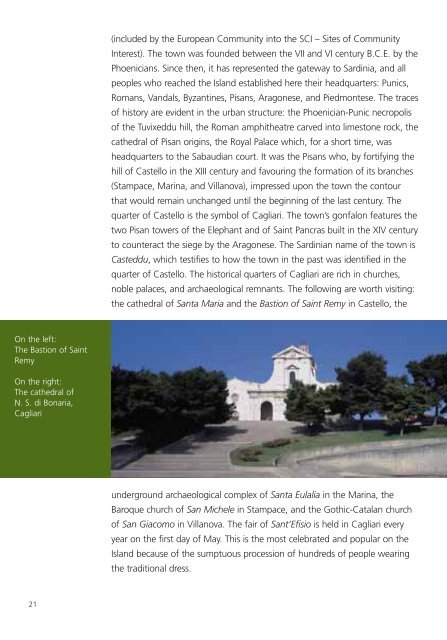Create successful ePaper yourself
Turn your PDF publications into a flip-book with our unique Google optimized e-Paper software.
(included by the European Community into the SCI – Sites of Community<br />
Interest). The town was founded between the VII and VI century B.C.E. by the<br />
Phoenicians. Since then, it has represented the gateway to Sardinia, and all<br />
peoples who reached the Island established here their headquarters: Punics,<br />
Romans, Vandals, Byzantines, Pisans, Aragonese, and Piedmontese. The traces<br />
of history are evident in the urban structure: the Phoenician-Punic necropolis<br />
of the Tuvixeddu hill, the Roman amphitheatre carved into limestone rock, the<br />
cathedral of Pisan origins, the Royal Palace which, for a short time, was<br />
headquarters to the Sabaudian court. It was the Pisans who, by fortifying the<br />
hill of Castello in the XIII century and favouring the formation of its branches<br />
(Stampace, Marina, and Villanova), impressed upon the town the contour<br />
that would remain unchanged until the beginning of the last century. The<br />
quarter of Castello is the symbol of Cagliari. The town’s gonfalon features the<br />
two Pisan towers of the Elephant and of Saint Pancras built in the XIV century<br />
to counteract the siege by the Aragonese. The Sardinian name of the town is<br />
Casteddu, which testifies to how the town in the past was identified in the<br />
quarter of Castello. The historical quarters of Cagliari are rich in churches,<br />
noble palaces, and archaeological remnants. The following are worth visiting:<br />
the cathedral of Santa Maria and the Bastion of Saint Remy in Castello, the<br />
On the left:<br />
The Bastion of Saint<br />
Remy<br />
On the right:<br />
The cathedral of<br />
N. S. di Bonaria,<br />
Cagliari<br />
underground archaeological complex of Santa Eulalia in the Marina, the<br />
Baroque church of San Michele in Stampace, and the Gothic-Catalan church<br />
of San Giacomo in Villanova. The fair of Sant’Efisio is held in Cagliari every<br />
year on the first day of May. This is the most celebrated and popular on the<br />
Island because of the sumptuous procession of hundreds of people wearing<br />
the traditional dress.<br />
21
















